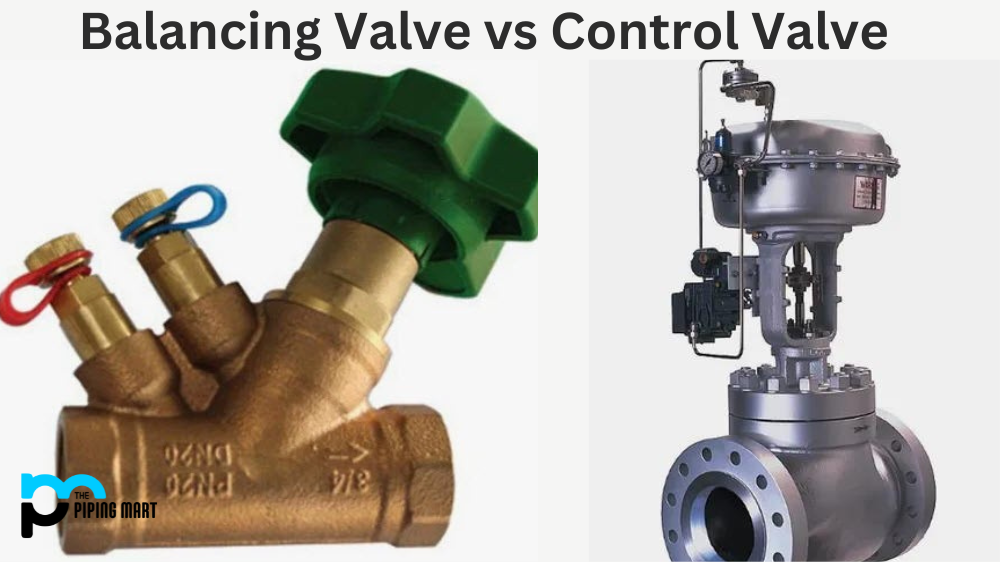Choosing the correct valve for your HVAC system can be tricky, especially if you need to become more familiar with the technicalities of the industry. Two commonly used valves in HVAC systems are balancing valves and control valves. While these valves serve different functions, their applications can often overlap, leading to confusion. This blog post will discuss the differences between balancing and control valves and how to choose the correct valve for your system.
What is a Balancing Valve?
A balancing valve is designed to balance and regulate the flow of liquids in an HVAC system. HVAC systems need a balanced flow of water or air to ensure efficient and even heating or cooling. By regulating the flow of liquid, a balancing valve helps control the pressure in the system and maintains an even flow. Balancing valves are usually used in large commercial HVAC systems with multiple zones or circuits. They help balance hot and cold water flow rates, ensuring the temperature is uniformly distributed.
What is a Control Valve?
A control valve regulates and controls the amount of fluid that passes through a pipe. It can open and close the line entirely or adjust the flow rate to meet the requirements of a particular zone or circuit. Control valves are used to regulate the temperature of a space. For example, if the temperature is too cold, the control valve may open up more to let in hot air or water. Control valves often use sensors and actuators to detect and adjust the flow rate and temperature. They are typically used in both residential and commercial HVAC systems.
Difference Between Balancing Valve and Control Valve
While balancing valves and control valves are designed to regulate liquid flow, they work differently. A balancing valve is used to get an equal flow of water or air into each zone. It’s designed to maintain the pressure and flow rate and balance the system. In contrast, the control valve adjusts the flow amount into a particular zone or circuit based on the temperature requirements. The control valve takes feedback from temperature sensors and opens and closes accordingly.
How do Balancing Valves Work?
Balancing valves work by controlling water flow in a heating or cooling system. The valves are designed to maintain a balance between the water flow and the system’s pressure, which helps ensure that the system operates efficiently.
How Do Control Valves Work?
Control valves work by regulating water flow in a heating or cooling system. The valves are designed to maintain a desired flow rate and pressure in the system, which helps to ensure that the system operates efficiently.
What are the Benefits of Using a Balancing Valve?
The benefits of using a balancing valve include improved efficiency, reduced wear and tear on parts, and extended equipment life. Additionally, balancing valves can help to enhance comfort levels by ensuring that rooms are evenly heated or cooled.
What are the Benefits of Using a Control Valve?
The benefits of using a control valve include improved efficiency, reduced wear and tear on parts, and extended equipment life. Additionally, control valves can help to enhance comfort levels by ensuring that rooms are evenly heated or cooled.
Are there any Drawbacks to Using a Balancing Valve?
Using a balancing valve has no significant drawbacks; however, they may only be necessary for some systems. Balancing valves are typically only used in scenarios with a significant difference between the water pressure and flow rate.
Are there any Drawbacks to using a Control Valve?
Using a control valve has no significant drawbacks; however, they may only be necessary for some systems.
How to Choose the Right Valve for Your System?
The choice between balancing and control valves depends on your needs. You will need a balancing valve if you have a commercial HVAC system with multiple zones requiring a balanced fluid flow. A control valve is a better option if a residential or small commercial HVAC unit requires precise temperature control. However, it’s important to note that in some cases, both valves may be used in the same system, with the balancing valve regulating the overall flow and the control valve adjusting the temperature of each zone.
Conclusion
In conclusion, the choice between a balancing valve and a control valve comes down to the specific requirements of your system. While the primary function of a balancing valve is to regulate and maintain the flow rate, a control valve adjusts the temperature of a particular zone or circuit. Understanding their differences will help you decide when to select the appropriate valve for your HVAC system. Always consult a professional HVAC contractor to ensure the correct valve is installed in your system.

Pipingmart is a B2B portal that specializes in metal, industrial and piping items. Additionally, we share the latest information and information about materials, products and various types of grades to assist businesses that are involved in this business.




